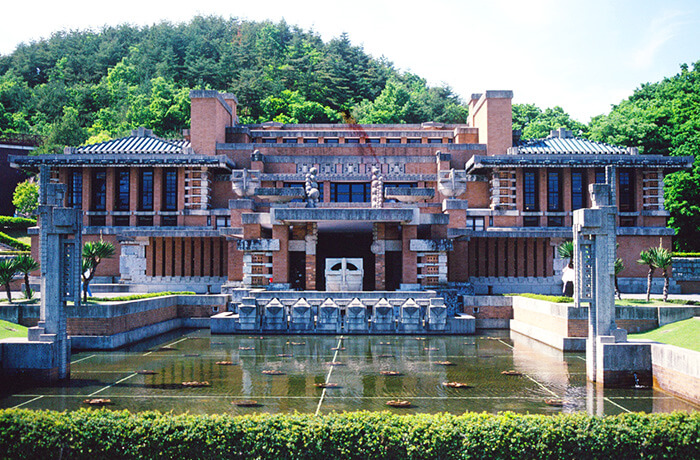Frank Lloyd Wright: “The architect must be a prophet …”
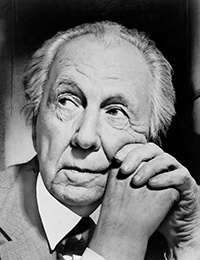
American Frank Lloyd Wright, born June 8, 1867 in Wisconsin, was not only one of the most famous architects in the world. He was also a writer, a collector and a philosopher. His designs — contradictory, inspiring, avant-garde, ahead of its time, are still relevant. His own philosophies of architecture, for example the belief that buildings are made of earth and must belong to the earth, are present in most of his works.
The constructions still so excite the imagination that, in 2011, the actress Angelina Jolie gave Brad Pitt, a great admirer of Wright and his iconic structure “Fallingwater”, a waterfall so that he could realize his dream of having a house soaring above the water.
“The architect must be a prophet”, Wright wrote. His contemporaries clearly had problems with understanding and acceptance of his vision. Of course, his work has been seen for decades now. His beliefs and ideals are practiced and supported today by many contemporaries. In his philosophy of architecture, a whole galaxy of unique architects of modernity was created, breaking stereotypes.
During his life, Wright created his own four styles, slowly flowing from one to another. This was reflected in the most famous “Prairies” (Preirie), created in contrast to the heavy and oppressive buildings of the Victorian era. Inspired by the straight-line architecture of the Maya, we see the “Textile” style. There is an awareness of Japanese culture in the “organic” architecture. Usonian was the fourth master of style, smoothly following from the preceding styles.
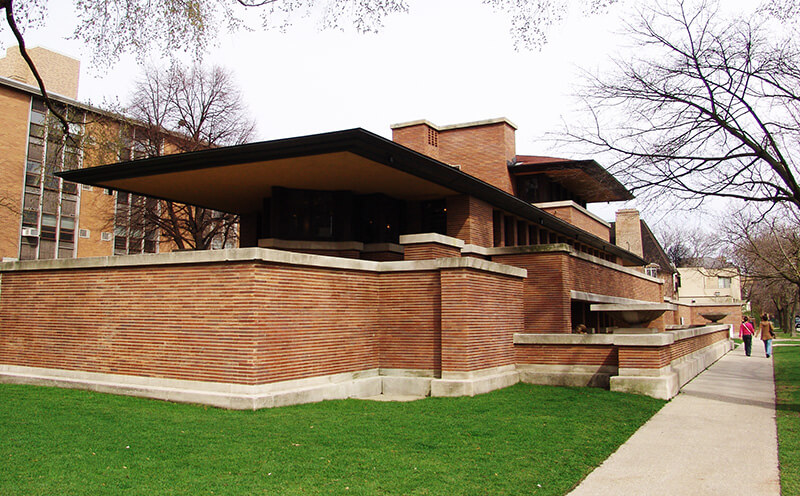
Luck smiled on Wright. For the first 10 years of the 20th century, the architect was able to bring to life a hundred projects. His beliefs are based on the ideas of Japanese architecture, expressed in the idea of continuing the architectural space of confidence. It is better to have fewer large rooms that would seamlessly flow into each other. This turned into “The House of the Prairie” being constructed in the United States.
“Robie House” (1910, Chicago) was the most prominent of the “prairie houses”. Complete lack of decor, asymmetrical shape, tape glazing, horizontal orientation and flat roofs with large overhangs make it look like a prairie. The house is organically “implanted” into the landscape.
During this period, Wright also created several objects in Japan. Designed in 1915, taking into account the seismological features of the area, the hotel “Imperial” survived during the earthquake of 1923, thanks to the powerful “floating” foundation, situated 18 metres deep into the ground and with floors on cantilevered suspension. Unfortunately, his works, like most of the buildings created by the architect in Japan, have not survived to the present day. During this period, the architect was in great demand, both at home and in Japan and Europe. Held in Berlin in 1910, his personal exhibition was immortalized in the chronicles of modern architecture.
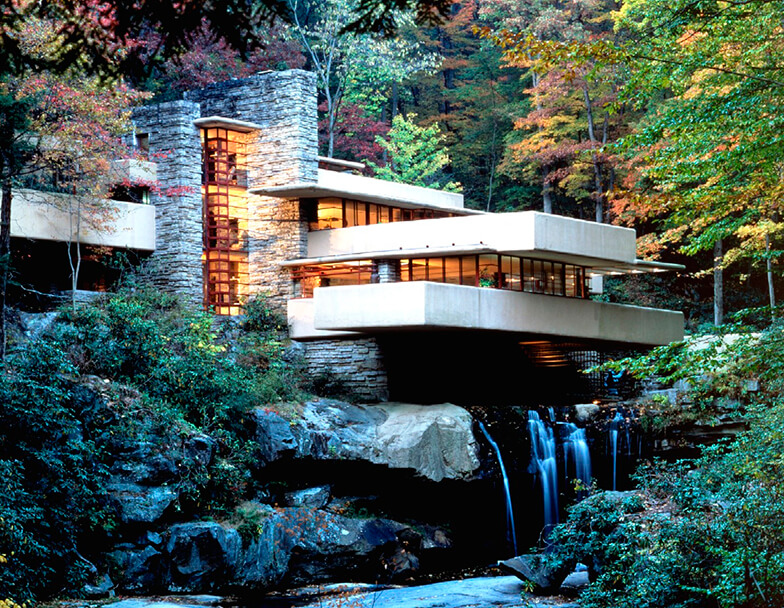
In the mid-twenties of the last century, there was Wright’s “black band”, where he suffered a serious creative crisis. The problems in his personal life did not add to his optimism. He seemed to become obsolete in the profession and he did not see any prospects. To make ends meet, he organized an art studio in his own home and Edgar Kaufmann came to study. This meeting was a landmark in the architect’s career. After receiving an order from the parents of Kaufman for the construction of a country house, Wright created one of his most famous works, “Fallingwater” (Pennsylvania, USA, 1939), which began the “white band” in the master’s career.
Fallingwater
A fine example of classic modernist architecture, this is the most famous building of the last century and is, perhaps, the best work of Wright. In it, he embodied his desire for bringing “organic” architecture to life. The building seemed to merge with the environment and dissolve in it, complementing it.
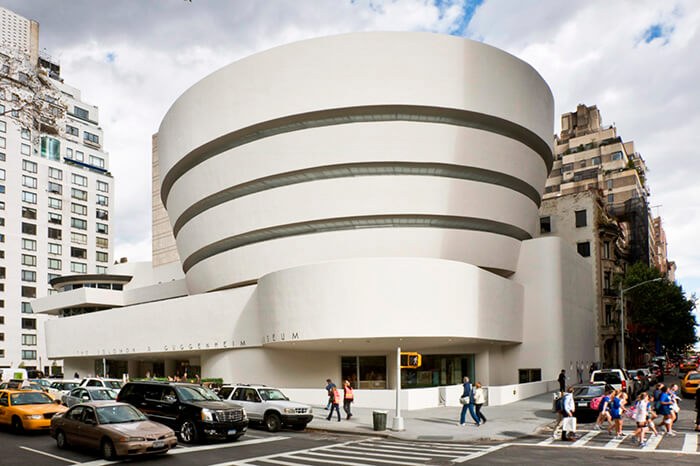
The history of this house is closely linked with the history of the Kaufmann family. Edgar and Liliana were not only a gorgeous couple, but also they had a successful business alliance, which turned into the family business. A shop that bears the name of the owners is a giant in the US market. They were successful, ambitious and good-looking.
They decided to implement the most incredible project in the history of architecture; a house built over a waterfall. However, Wright, during construction, made an error in the calculation of load-bearing structures, which caused a quarrel with the customer, who insisted on additional reinforcements. Wright was confident. When, after the end of construction, the concrete began to settle, an impressive crack formed on one of the terraces and load-bearing structures had to be strengthened. To comply with a unified style, Wright also designed the entire interior, including furniture: beds, tables, chairs, shelves and lamps.
The house is the envy of many. For the owners, it did not bring happiness. Rooms got damp in the winter. In summer, they were stuffy and the privacy of the couple was not idyllic. Edgar was very popular with the opposite sex and not particularly interested in keeping secret his adventures. A scandal arose and his wife’s health was eventually seriously undermined by the stress of all that went on. This story even made it into the newspapers and became available to the general public.
Another affair with a nurse, Grace Stoops, apparently blew it completely. One day, the wife was found by her husband in the “House of Waterfall” unconscious. Most likely, it was an overdose of drugs. Edgar Sr. decided not to take her to a local hospital and into the city instead. This trip cost Liliana her life. Two years later, Kaufmann Sr., standing on the threshold of his 70th birthday, married his 34-year-old mistress Stoops. After only a few months, he died, never fully enjoying family life with his young wife.
Maintaining a home requires constant and serious investments. Therefore, in 1963, the son of Kaufmann, Edgar, decided to transfer the house to local community protection of monuments, as it had never brought happiness of its owners. Since then, the house has been a museum. About a hundred thousand tourists come there every year to see this unique structure with their own eyes.
After the construction of the “House of Waterfall”, Wright again became very popular and in demand until the end of his life. He implemented new projects and published books and articles. Another cult work of the master, built later, was called “Museum of Contemporary Art Solomon Guggenheim” (New York, USA, 1959).
It was designed and built over 16 years. Outside of it is an inverted spiral and the interior resembles a shell, which is located in the centre of a glazed patio. As conceived by the architect, to fully examine the structure, it is necessary to start from the top, up to the elevator and gradually descend down the hung works of art. In practice, however, visitors begin inspection from below. The fate and career of the beautiful architect, Frank Lloyd Wright, is not just about talent, but also about his willpower, self-control and self-confidence. He survived the onslaught of criticism and endured years of neglect. Then, he simply went on to create more.
